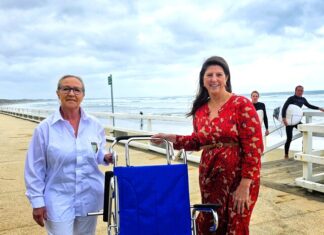Hamish Heard
A family’s pleas for a memorial to mark the place where a teenage girl died in a collision with a train have fallen on deaf ears, according to the girl’s mother.
Norlane mother Kerry Stringer watched in horror as an express train collided with her 14yearold daughter Sarah at North Shore Station, killing her instantly in September, 2005.
“Sarah was a very special person and we really want this memorial to have something to remember her by in the spot where she took her last breath and also to drive home the message that people have to be careful around trains,” Mrs Stringer said.
“This has taken a huge toll on all of us, my marriage has split up and all of our lives have gone downhill.”
The family wanted a monument the same height as Sarah where she attempted to cross the tracks.
But Slater and Gordon lawyer Phil Hill, who is representing the Stringer family in a damages claim against V/Line, claimed the company was “dragging its heels” over the request.
“It would seem reasonable for the family to get some resolution in terms of getting a physical symbol of the tragedy at the location where it actually occurred,” Mr Hill said.
“After an ongoing exchange of correspondence (V/Line) now appears reluctant to deal with that request,” he said.
Mr Hill said he was preparing to file a damages claim against rail operators Pacific National and V/Line.
“This has taken a huge toll on all of us, my marriage has split up and all of our lives have gone downhill.”
A V/Line spokesperson said the company had proposed several options for a memorial plaque but the Stringer family had rejected each proposal.
The spokesperson said V/Line had opposed the family’s proposal for a 162cm monument on safety grounds.
“A memorial of this height at this location could potentially distract drivers and pose a safety hazard,” the spokesperson said.
“This safety position is held by other rail operators in Victoria.”
The spokesperson said V/Line wanted to reach an agreement with the family and would continue discussions “within our safety constraints”.
Get the latest news to your email inbox FREE!
REGISTER





